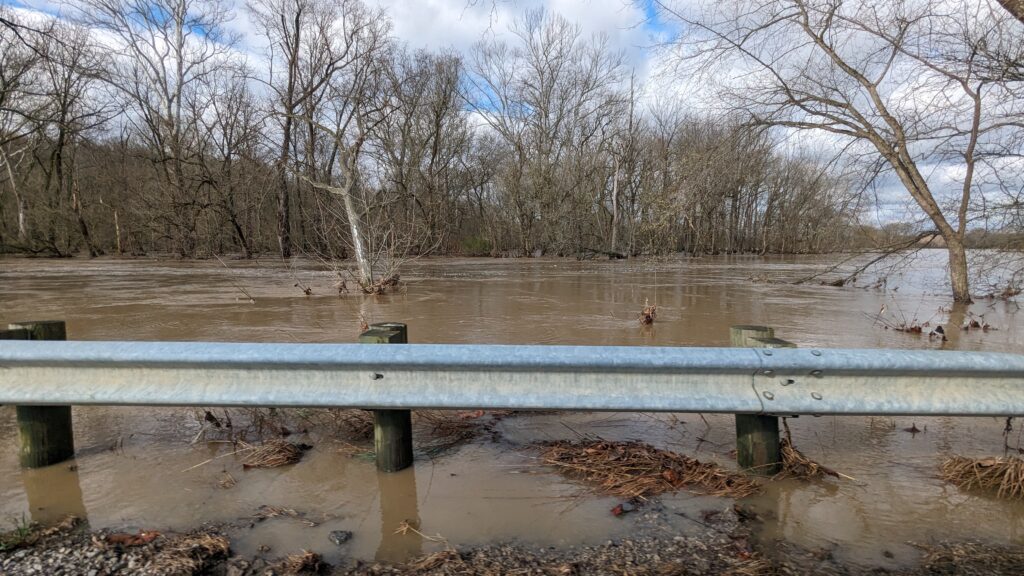As rain fell in sheets on April 2, the Licking River rose quickly and a Newark city crew installed the floodgate across South 2nd Street in the Little Texas neighborhood, a collection of modest homes sitting in a vulnerable position at the confluence of the Licking River and the South Fork of the Licking River.
About the same time, police officers began telling residents of that neighborhood and the Canterbury Trails mobile home park, also on the south side along the South Fork, that they should consider evacuating their homes to avoid potential flooding.
But no one in Newark had informed the Licking County Emergency Management Agency that a voluntary evacuation was being considered, said EMA Director Sean Grady, and that left his agency a step behind when it came to implementing its action plan to work with its partners to set up a shelter.
The April 2 situation revealed that while some plans for emergency sheltering due to mass housing emergencies are in place, not everyone knows the details, said Deb Dingus, executive director of The United Way of Licking County. And the plans don’t cover all types of housing emergencies, she said.
Her agency is inviting local first responders, social service agencies and local government officials to meet early in May to work toward closing gaps in communication and developing plans for emergencies that fall outside of those considered “disasters” commonly handled by EMA and the Red Cross – blizzards, fires, floods and tornadoes.
Those other emergencies would include situations such as one that developed into a housing crisis last summer when about 60 residents of a Buckeye Lake motel were told by a local building inspector to evacuate the facility.
“We want to do a better job of being prepared and getting ahead of communication for mass housing emergencies,” Dingus said. “They can be from an eviction, health issue, flood, fire, or tornado. The situation is the same, and the question is, how can we best help people who are suddenly finding themselves unsheltered because of these situations?
“I’d like to see these plans in writing and shared, and then have a regular meeting to discuss our disaster readiness,” she said.
Grady said that in times of bad weather, his EMA team closely monitors the conditions, and on April 2, he said, “We knew it was going to be close.”



“There was a lot of angst,” he said. “We were sending advisories that it was going to be close, but didn’t expect it to get to the point of needing a shelter.”
Sign up for EMA advisories here: https://signup.hyper-reach.com/hyper_reach/sign_up_page_2/?id=112923.
When any local emergency responders feel the time has come for evacuation, he said, they need to contact the EMA immediately so that it can activate the emergency plans that involve a network of partners and volunteers.
“Newark should have reached out to us,” he said.
Newark Safety Director Tim Hickman said he wasn’t aware of that protocol.
“No, there’s no plan that I’m aware of that’s in place; it’s just a case-by-case, incident-by-incident type of situation. No, there’s no talks or any sort of legislation at this point,” Hickman said.
Newark Police Sgt. Chuck Wilhelm said the situation in which they found themselves on April 2 is not one the department has experienced often.
“It was right around 4 o’clock (that) they put the floodgates up on Second Street. I’ve only seen those up two times in my career, and I’ve been here for 33 years,” Wilhelm said.
So, at the request of the Newark Fire Department, police officers began asking residents to leave their homes to avoid potential flooding.
“The way our shifts work, the first shift and second shift overlap for like an hour and a half,” Wilhelm said. “So we had all kinds of cruisers and all kinds of manpower, so we just hit the neighborhoods and asked people to voluntarily evacuate at the request of the fire department.”
But that left residents wondering: If we leave, where should we go?
Some took to social media asking that question and wondering whether there was a plan for such emergencies. In the end, most did not leave their homes, and, fortunately, flooding was minimal and the floodgates were removed by 10 a.m. the next day.
Grady said there’s definitely a plan, and he is grateful for all of the partners who work to implement it. Chief among them is the Red Cross and its partners. In this case, it was Holy Trinity Lutheran Church on West Main Street, which scrambled volunteers in less than an hour after being contacted by the Red Cross to open the church by 6 p.m. to serve as a shelter.
The Red Cross then showed up with its trailer full of supplies and volunteers to staff the shelter.
“The way it works,” said Rod Cook, executive director of the Red Cross East Central Ohio Chapter, “is that Sean Grady makes the call whether or not evacuations are needed, and the EMA triggers us to open a shelter. We have pre-identified locations set up so that we know how to contact folks, especially after hours, so we can open a shelter.”
He said the national standard for the Red Cross is to have a shelter set up within two hours of being alerted to the need. So the message from Grady is that the sooner the EMA office gets the call, the sooner the Red Cross can spring into action.
“We have these pre-signed agreements with partners ahead of time, and have all of our supplies – cots, blankets, paperwork, nurses kits – in a trailer ready to go. Food depends on the situation. We have feeding agreements in place with partners.”
In addition to those partners, they communicate with the Licking County Health Department to spread awareness on social media.
“Our job there really is to promote it,” said Health Commissioner Chad Brown. “I got a call from Sean Grady at Licking County EMA saying that the Red Cross was going to go to Holy Trinity Church. All we did was put on Facebook that the shelter was open.”
The Health Department offered Holy Trinity additional staff and a nurse, but fortunately, neither were needed.
Licking Memorial Hospital provided food for the shelter, said Dingus, who in addition to being the United Way director is also pastor of Holy Trinity Lutheran Church, site of the temporary shelter.
“The hospital provided hot dogs, chips and fruit, and we had some food for breakfast,” she said, adding that the shelter “consistently had about six people” from soon after it opened at 6 p.m. until about 9 a.m. the next day.
The shelter was on alert in the middle of the night for the possibility of more evacuees after Heath authorities notified Grady well after midnight that they feared the South Fork of the Licking River could swamp homes along Licking View Drive. The water ultimately came within inches of the roadway, Grady said, but didn’t get to the homes.
Grady and Cook said the network of partners and volunteers is key to the success of such operations.
“Even as we speak, we have teams up in Bucyrus,” said Cook, whose Red Cross chapter covers 12 counties – Crawford, Coshocton, Knox, Marion, Morrow and Richland to the north, and Guernsey, Licking, Muskingum, Morgan, Noble and Perry to the east and south of its home base in Newark.
Crawford County is where storms that may have included tornadoes damaged homes and other buildings in and near Bucyrus on April 17. In the past month, Cook said, his Red Cross chapter has responded to seven counties related to bad-weather emergencies. And that does not include incidents such as the two-alarm fire in March in downtown Newark that displaced 24 residents of the historic Avalon Building.
“We do it with our dedicated volunteers,” he said. “They are absolutely critical. We have so many, from churches, to social service organizations to government agencies.”
He said some people think the Red Cross is a government agency or funded by the government. “We are a private, nonprofit organization that is dependent on our local communities. However, our disaster services are mandated by Congress but not funded by Congress.”
Looking to the future, Dingus said she’s eager to see everyone’s plans and to make sure that any gaps between them are filled.
“The EMA, the Red Cross, the Health Department – they are all good people and all have plans,” she said. “We need an organized, overall plan” that includes those mass housing emergencies that are triggered by something other than a fire or natural disaster.
And the overall plan should look to a future that includes the effects of the tight housing market in Licking County and the impact of climate change, which could require such things as designated cooling centers in the heat of summer.
“We need to create long-term, temporary housing,” Dingus said. “God forbid we had a tornado that (hits many houses). Where would we set up FEMA trailers? And who helps with the cost of this? Do we have money set aside for these emergencies?”
Grady said he is looking forward to the broader conversation about planning and preparedness.
“We’re pushing the preparedness message,” he said. “As much as possible, we are trying to get people to be more resilient – to be aware of your surroundings and be prepared, and we want to keep people informed so they can be safe.”
“We learn something new from every event,” he said.
Noah Fishman and Alan Miller write for TheReportingProject.org, the nonprofit news organization of Denison University’s Journalism program, which is funded by the Mellon Foundation and donations from readers.

